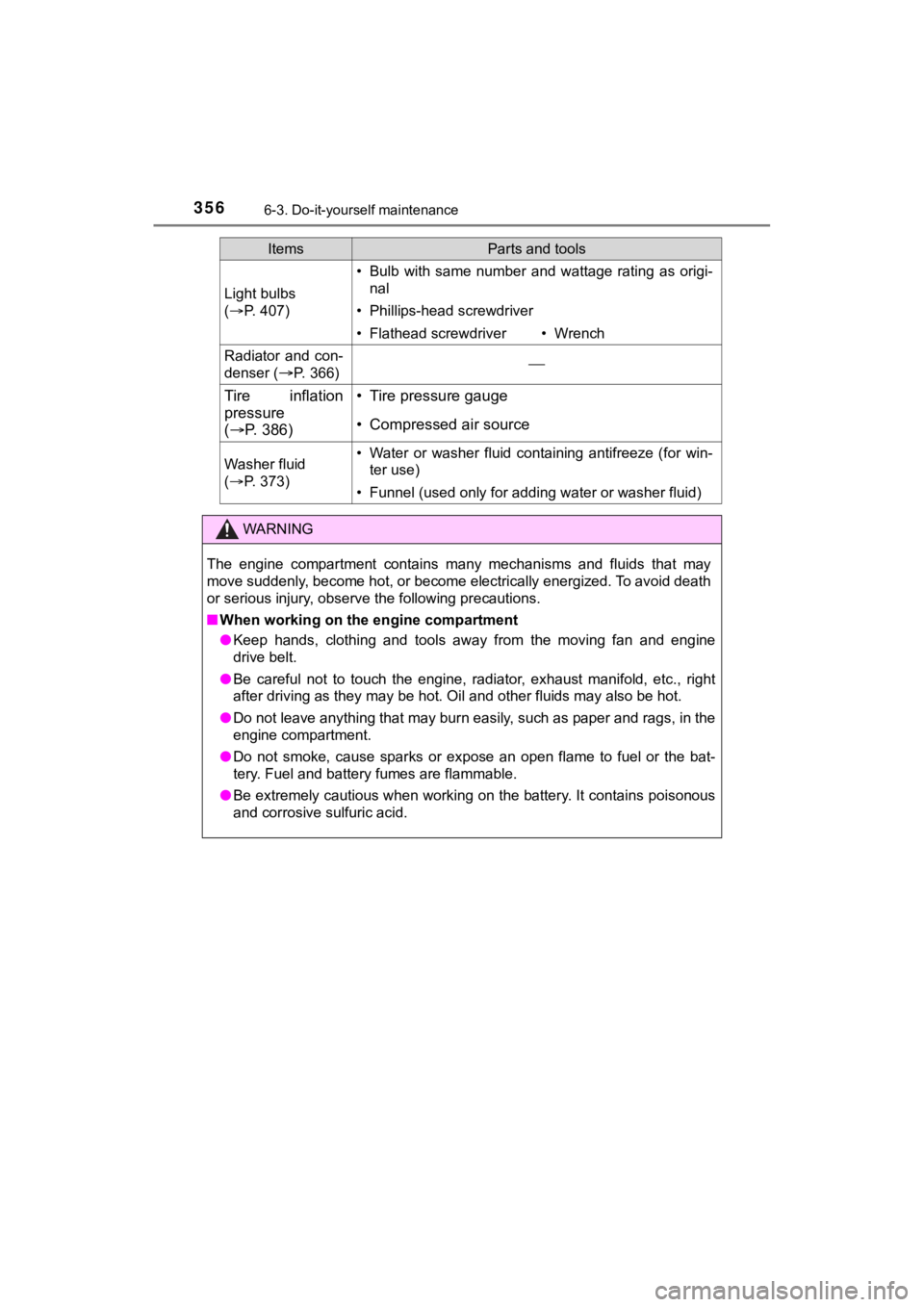2021 TOYOTA C-HR inflation pressure
[x] Cancel search: inflation pressurePage 4 of 548

TABLE OF CONTENTS4
C-HR_OM_USA_OM10684U5-1. Using the air conditioning
system and defogger
Air conditioning system ..... 312
Heated steering wheel/ seat heaters .................... 321
5-2. Using the interior lights Interior lights list ................ 323• Interior lights ................. 324
• Personal lights .............. 325
5-3. Using the storage features List of storage features...... 326• Glove box...................... 327
• Console box .................. 327
• Bottle holders ................ 328
• Cup holders .................. 329
Luggage compartment features ........................... 330
5-4. Using the other interior features
Other interior features ....... 336 • Sun visors ..................... 336
• Vanity mirrors................ 336
• Power outlet .................. 337
• Assist grips ................... 338 6-1. Maintenance and care
Cleaning and protecting the vehicle exterior .......... 340
Cleaning and protecting the vehicle interior ................. 344
6-2. Maintenance Maintenance requirements ................... 347
General maintenance ........ 350
Emission inspection and maintenance (I/M)
programs ......................... 354
6-3. Do-it-yourself maintenance Do-it-yourself service precautions ...................... 355
Hood .................................. 358
Positioning a floor jack....... 360
Engine compartment ......... 361
Tires................................... 376
Tire inflation pressure ........ 386
Wheels............................... 390
Air conditioning filter .......... 393
Wireless remote control/ electronic key battery ...... 397
Checking and replacing fuses ................................ 401
Headlight aim (vehicles with front fog lights)................. 405
Light bulbs ......................... 407
5Interior features6Maintenance and care
Page 15 of 548

15Pictorial index
C-HR_OM_USA_OM10684UWindshield wipers . . . . . . . . . . . . . . . . . . . . . . . . . . . . . . . . . P. 215
Precautions for winter . . . . . . . . . . . . . . . . . . . . . . . . . . . . . . . P. 306
To prevent freezing (windshield wiper de-icer)
*1. . . . . . . . . . . P. 315
Fuel filler door . . . . . . . . . . . . . . . . . . . . . . . . . . . . . . . . . . . . P. 220
Refueling method . . . . . . . . . . . . . . . . . . . . . . . . . . . . . . . . . . . P. 220
Fuel type/fuel tank capacity . . . . . . . . . . . . . . . . . . . . . . . . . . . P. 478
Tires . . . . . . . . . . . . . . . . . . . . . . . . . . . . . . . . . . . . . . . . . . . . P. 376
Tire size/inflation pressure . . . . . . . . . . . . . . . . . . . . . . . . . P. 482
Winter tires/tire chains . . . . . . . . . . . . . . . . . . . . . . . . . . . . P. 306
Checking/rotation/tire pressur e warning system . . . . . . . . .P. 376
Coping with flat tires . . . . . . . . . . . . . . . . . . . . . . . . . . . . . . P. 449
Hood . . . . . . . . . . . . . . . . . . . . . . . . . . . . . . . . . . . . . . . . . . . . P. 358
Opening . . . . . . . . . . . . . . . . . . . . . . . . . . . . . . . . . . . . . . . . . . P. 358
Engine oil . . . . . . . . . . . . . . . . . . . . . . . . . . . . . . . . . . . . . . . . . P. 478
Coping with overheating . . . . . . . . . . . . . . . . . . . . . . . . . . . . . P. 470
Camera
*2
Front side marker lights . . . . . . . . . . . . . . . . . . . . . . . . . . . . P. 204
Headlights . . . . . . . . . . . . . . . . . . . . . . . . . . . . . . . . . . . . . . . P. 204
Front fog lights
*1. . . . . . . . . . . . . . . . . . . . . . . . . . . . . . . . . . P. 214
Parking lights/daytime running lights . . . . . . . . . . . . . . . . . P. 204
Front turn signal . . . . . . . . . . . . . . . . . . . . . . . . . . . . . . . . . . P. 195
Parking lights/daytime running lights (LED type). . . . . . . . P. 204
Side turn signal lights . . . . . . . . . . . . . . . . . . . . . . . . . . . . . . P. 195
Tail lights/side marker lights/turn signal lights. . . . . . P. 195, 204
Back-up lights
Shifting the shift lever to R . . . . . . . . . . . . . . . . . . . . . . . . . . . . P. 190
License plate lights . . . . . . . . . . . . . . . . . . . . . . . . . . . . . . . . P. 204
Light bulbs of the exterior lights for driving
(Replacing method: P. 407, Watts: P. 483)
*1: If equipped
*2: Refer to “MULTIMEDIA OWNER’S MANUAL”.
Page 245 of 548

2454-5. Using the driving support systems
4
Driving
C-HR_OM_USA_OM10684U●
In addition to the above, in some situations, such as the follo wing, the emer-
gency steering assist may not operate.
• When the white (yellow) lane lines are difficult to see, such as when they
are faint, diverging/merging, or a shadow is cast upon them
• When the lane is wider or narrower than normal
• When there is a light and dark pattern on the road surface, su ch as due to
road repairs
• When a pedestrian is detected near the centerline of the vehic le
• When the target is too close
• When there is insufficient safe or unobstructed space for the vehicle to be
steered into
• If oncoming vehicle is present
• If VSC function is operating
● In some situations such as the following, sufficient braking force or steering
force may not be obtained, preventing the system from performin g properly:
• If the braking functions cannot operate to their full extent, such as when
the brake parts are extremely cold, extremely hot, or wet
• If the vehicle is not properly maintained (brakes or tires are excessively
worn, improper tire inflation pressure, etc.)
• When the vehicle is being driven on a gravel road or other sli ppery sur-
face
• When the road surface has deep wheel tracks
• When driving on a hill road
• When driving on a road that has inclines to the left or right
■ If VSC is disabled
●If VSC is disabled ( P. 302), the pre-collision brake assist and pre-collision
braking functions are also disabled.
● The PCS warning light will turn on and “VSC Turned Off. Pre-Col lision
Brake System Unavailable.” will be displayed on the multi-infor mation dis-
play. • While making a right/left turn, when a
pedestrian approaches from behind
or side of your vehicle
Page 305 of 548

3054-5. Using the driving support systems
4
Driving
C-HR_OM_USA_OM10684U
WARNING
■When the TRAC/VSC is activated
The slip indicator light flashes. Always drive carefully. Reckless driving may
cause an accident. Exercise particular care when the indicator light flashes.
■ When the TRAC/VSC systems are turned off
Be especially careful and drive at a speed appropriate to the r oad condi-
tions. As these are the systems to help ensure vehicle stabilit y and driving
force, do not turn the TRAC/VSC systems off unless necessary.
■ Replacing tires
Make sure that all tires are of the specified size, brand, trea d pattern and
total load capacity. In addition, make sure that the tires are inflated to the
recommended tire inflation pressure level.
The ABS, TRAC and VSC systems will not function correctly if di fferent tires
are installed on the vehicle.
Contact your Toyota dealer for further information when replaci ng tires or
wheels.
■ Handling of tires and the suspension
Using tires with any kind of problem or modifying the suspensio n will affect
the driving assist systems, and may cause a system to malfuncti on.
Page 339 of 548

339
6Maintenance and care
C-HR_OM_USA_OM10684U6-1. Maintenance and care
Cleaning and protecting the vehicle exterior ................ 340
Cleaning and protecting the vehicle interior ................. 344 6-2. Maintenance
Maintenance requirements ................... 347
General maintenance........ 350
Emission inspection and maintenance (I/M)
programs......................... 354
6-3. Do-it-yourself maintenance
Do-it-yourself service precautions ..................... 355
Hood ................................. 358
Positioning a floor jack ...... 360
Engine compartment ......... 361
Tires .................................. 376
Tire inflation pressure ....... 386
Wheels .............................. 390
Air conditioning filter.......... 393
Wireless remote control/ electronic key battery ...... 397
Checking and replacing fuses ............................... 401
Headlight aim (vehicles with front fog lights) ......... 405
Light bulbs......................... 407
Page 356 of 548

3566-3. Do-it-yourself maintenance
C-HR_OM_USA_OM10684U
Light bulbs
( P. 4 0 7 )
• Bulb with same number and wattage rating as origi-
nal
• Phillips-head screwdriver
• Flathead screwdriver• Wrench
Radiator and con-
denser (
P. 366)
Tire inflation
pressure
( P. 386)• Tire pressure gauge
• Compressed air source
Washer fluid
( P. 3 7 3 )• Water or washer fluid containing antifreeze (for win-
ter use)
• Funnel (used only for adding water or washer fluid)
WARNING
The engine compartment contains many mechanisms and fluids that may
move suddenly, become hot, or become electrically energized. To avoid death
or serious injury, observe the following precautions.
■When working on the engine compartment
● Keep hands, clothing and tools away from the moving fan and eng ine
drive belt.
● Be careful not to touch the engine, radiator, exhaust manifold, etc., right
after driving as they may be hot. Oil and other fluids may also be hot.
● Do not leave anything that may burn easily, such as paper and r ags, in the
engine compartment.
● Do not smoke, cause sparks or expose an open flame to fuel or t he bat-
tery. Fuel and battery fumes are flammable.
● Be extremely cautious when working on the battery. It contains poisonous
and corrosive sulfuric acid.
ItemsParts and tools
Page 377 of 548

3776-3. Do-it-yourself maintenance
6
Maintenance and care
C-HR_OM_USA_OM10684U
Your vehicle is equipped with a tire pressure warning system that uses
tire pressure warning valves and transmitters to detect low tire infla-
tion pressure before serious problems arise.
If the tire pressure drops below a predetermined level, the dri ver is
warned by a warning light. ( P. 437)
◆Installing tire pressure warn ing valves and transmitters
When replacing tires or wheels, tire pressure warning valves an d
transmitters must also be installed.
When new tire pressure warning valves and transmitters are
installed, new ID codes must be registered in the tire pressure
warning computer and the tire pressure warning system must be
initialized. Have tire pressure warning valves and transmitter ID
codes registered by your Toyota dealer. ( P. 379)
◆Initializing the tire pressure warning system
When the tire size is changed, the tire pressure warning system
must be initialized.
When the tire pressure warning sy stem is initialized, the current tire
inflation pressure is set as the benchmark pressure.
Tire pressure warning system
Page 378 of 548

3786-3. Do-it-yourself maintenance
C-HR_OM_USA_OM10684U■
How to initialize the tire pressure warning system
Park the vehicle in a safe plac e and turn the engine switch to the
“LOCK” position (vehicles with out a smart key system) or off
(vehicles with a sm art key system).
Initialization cannot be perfo rmed while the vehicle is moving.
Adjust the tire inflation pressure to the specified cold tire i nflation
pressure level. ( P. 482)
Make sure to adjust the tire pre ssure to the specified cold tire infla-
tion pressure level. The tire pressure warning system will oper ate
based on this pr essure level.
Turn the engine switch to the “ON” position (vehicles without a
smart key system) or IGNITION ON mode (vehicles with a smart
key system).
Press “” or “ ” of the meter control switch to select .
( P. 100)
Press “ ” or “ ” of the meter control switch to select the “Vehicle
Settings” and then press to display the menu.
Press “ ” or “ ” of the meter
control switch to select
and then press
.
Press “ ” or “ ” of the meter control switch to select “SET” and
then press and hold .
When initialization completes, a message is displayed on the
multi-information display and the tire pressure warning light w ill
blink 3 times.
1
2
3
4
5
6
7
8